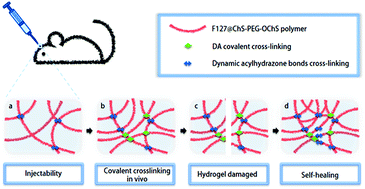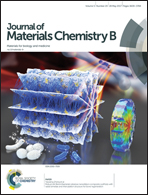An injectable and self-healing hydrogel with covalent cross-linking in vivo for cranial bone repair†
Abstract
Current hydrogels based on chondroitin sulfate (ChS) generally lack the necessary strength and precise mechanical tunability. Addressing these limitations, covalent cross-linking has evolved to produce hydrogels with desirable properties. However, such a methodology always precludes injection and self-healing. In this study, we employ DA click chemistry and dynamic acylhydrazone bond cross-linking for hydrogel formation that overcomes the limitations of current ChS hydrogels. Dynamic acylhydrazone bonds afford the hydrogel injectability and self-healing ability, while DA click chemistry facilitates the employment of covalent crosslinking for stabilization in vivo and modulating hydrogel properties in vivo. The study reveals that the obtained hydrogel possesses highly tunable viscoelastic and rheological properties, swelling and degradation behavior, and injectability and self-healing ability compared with ChS hydrogels cross-linked by single DA click chemistry or acylhydrazone bonds. Meanwhile, this hydrogel shows increased viability and reduced apoptosis of rat mesenchymal stem cells, and excellent tissue adhesive ability in vivo. The hydrogel was loaded with BMP-4 and used as a scaffold for rat cranial bone tissue engineering. The results demonstrated that new bone tissue was detected in the defected area of the cranial bone. Thus, this cytocompatible, injectable and self-healing hydrogel with tunable properties can be used as a scaffold for cranial bone tissue engineering and promote bone formation.



 Please wait while we load your content...
Please wait while we load your content...